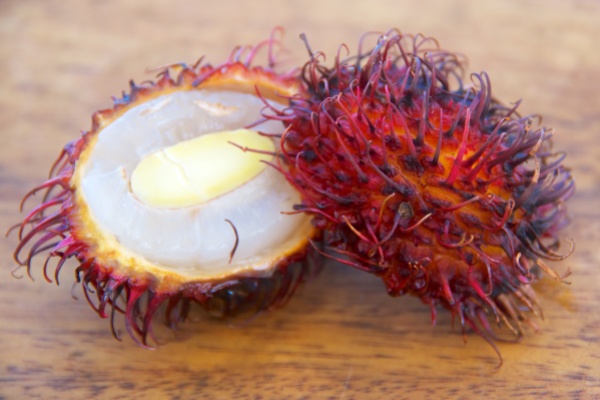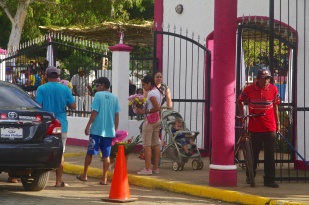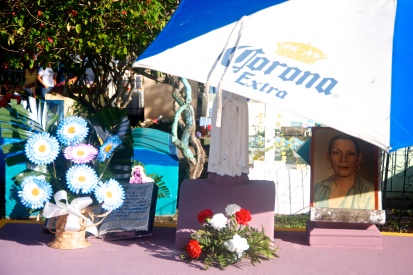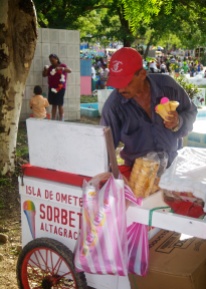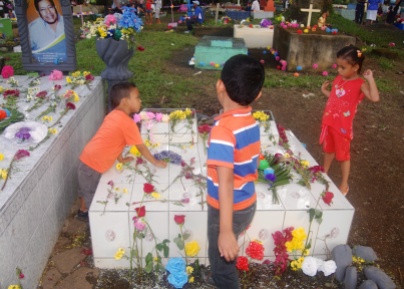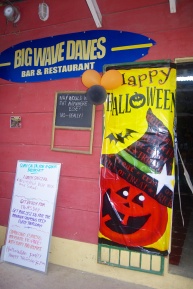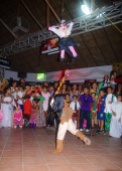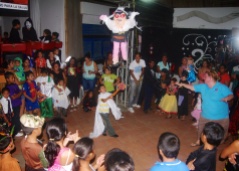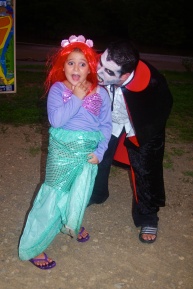Photo Journalism Friday: The Christ of the Mercy

The Christ of the Mercy statue was erected in 2009 and and has quickly become an ionic landmark and geographical reference point for the town of San Juan del Sur. At 24 meters it is the largest statue of Christ in Central America and one of the 10 largest Jesus statues in the world. El Cristo de la Misericordia was the dream of a local businessman, Erwin Gonzalez, who made his fortune from tourism.
Mercado Monday: Mamón Chino (Rambutan)
Buying Guide:
There is no real trick to finding ripe mamón chino. If they are red they are ready to go.
How to Eat It:
Mamón chino is a great fruit to eat on the run. Just pinch or bite a small hole in the skin and peel it away to expose the flesh inside. Then just pop the whole thing into your mouth and chew and suck the flesh off the seed inside.
Flavor:
Mamón chino (also referred to as rambutan) is a cousin to the much more well-known lychee fruit. The two taste very similar. They are sweet and slightly tart, with the consistency of a firm grape.
Harvesting Season:
Mamón chino can be harvested twice per year, but is most prevalent July through September.
Nutrition:
Mamón chino is low in calories and high in Vitamin C, iron and anti-oxidants.
Interesting Facts:
Mamón chino roughly translated means “Chinese sucker”. Originating from Indonesia and Malaysia it can be found growing naturally all over Southeast Asia. Most Nicaraguans refer to people of any Asian descent as Chinese. For example, our good friend Kenny is Hawaiian. Locals refer to him as “chinito” (cute little China man). Thinking in true Nica logic – a fruit of Asian background that you suck on – should obviously be called a Chinese sucker.
We’ve Got 2 More “Red Hot” Real Estate Deals for You!
We’ve got 2 more red hot real estate deals to share with you.
SMALL SCALE TURN KEY RESTAURANT in SAN JUAN DEL SUR
COLONIAL HOME WITH SWIMMING POOL in GRANADA
View these ads (and more value priced properties) on our Hot Deals: Real Estate page!
International Living Article #4
Click anywhere on the image or text below to read my most recent International Living article.
What I Ate Today: Ceviche de Camarones

Ceviche (“seh-BEE-chay”)
The first time I was introduced to ceviche was almost eight years ago in a restaurant in Playa del Coco, Costa Rica.
“Gord, you can’t eat that! It’s raw fish. You’re going to get sick.”
I was so wrong!
This hugely popular Central American dish is made from fresh raw fish marinated in lime juice, and spiced with chili peppers. Additional seasonings, such as chopped onions and salt are also added.
Is ceviche cooked?
A dish in which raw fish is marinated in citrus juice, isn’t cooked. But it’s not exactly raw, either. Both heat and citric acid are agents of a chemical process called denaturation. In this process, the heat or citric acid changes the proteins in the fish, unraveling the molecules and altering their chemical and physical properties. When fish is bathed in citrus juices, this process of denaturation turns the flesh firm and opaque, as if it had been cooked with heat.
Ceviche spooned onto crackers with a dash of chile now happens to be one of my favorite appetizers. It’s a nice light tasty snack that is great for sharing.
If you enjoy fish (cooked or raw) and have yet to sample ceviche I high recommend you give it a try. I don’t think you’ll be disappointed!
Author’s Note: The dish shown in the photo is a shrimp ceviche that I enjoyed poolside at Rocamar restaurant in San Juan del Sur. Cost was C$110 ($4.40 USD).
Mercado Monday: Passion Fruit (Calala or Maracuya)
Buying Guide:
Select calala that feels heavy for its size. If the skin on the fruit appears glossy yellow or green it is not ready to be eaten. Wait until the skin gets blotchy and starts to shrivel and wrinkle, like an old man’s skin. Even then the inside of the calala may still be yellow and quite sour. When calala looks almost spoiled on the outside the fruit on the inside will be vibrant orange in color and little bit sweet.
Flavor: The juice and pulp of calala is slightly sweet and very tart with a unique burst of citrus flavor. The seeds are surrounded by the pulp of the fruit and are meant to be eaten. They add a nice crunch and provide an incredible amount of fibre.
How to Eat It:
Calala is the one fruit where you eat the seeds and discard the skin. It is often used in juices and smoothies. When added to something very sweet like a banana and pineapple smoothie the calala’s acidity cuts through the sweetness an adds an incredible punch of citrus flavor. My personal favorite way to eat calala is to scoop the seeds and pulp into a bowl, add some natural yogurt, a banana and a handful of roasted cacao beans. The creamy, sweet, sour, bitter, crunchy combination of flavors and texture is amazing.
Harvesting Season:
Passion fruit can be found year round, but high season for this fruit is October through February.
Nutrition:
Like many fruits calala is high in Vitamin A, C and antioxidants. It is also incredibly high in fibre. Passion fruit offers a good dose of B vitamins, potassium and loads of minerals like iron, copper, magnesium and phosphorus.
Interesting Facts:
The ugly appearance of the skin combined with the weird seedy goopy interior makes the calala one of the ugliest – but most delicious fruits – I eat. Having a calala is part of my daily ritual.
Photo Journalism Friday: Roosters on Her Head

As Gord and I sipped our fresh fruit smoothies watching passerby on the beach this lady and her grandson approached us. Roosters made from seashells don’t fall under our preferred style of home decor so we offered to buy her and the boy a juice. I often wonder how many of these pieces they sell in a day? A week? How long does it take to make one and how much do they cost? Instead of immediately saying, “No gracias”, I should have taken some time to have a conversation with her and ask a few questions. Next time!





